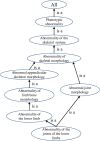HPOSim: an R package for phenotypic similarity measure and enrichment analysis based on the human phenotype ontology
- PMID: 25664462
- PMCID: PMC4321842
- DOI: 10.1371/journal.pone.0115692
HPOSim: an R package for phenotypic similarity measure and enrichment analysis based on the human phenotype ontology
Abstract
Background: Phenotypic features associated with genes and diseases play an important role in disease-related studies and most of the available methods focus solely on the Online Mendelian Inheritance in Man (OMIM) database without considering the controlled vocabulary. The Human Phenotype Ontology (HPO) provides a standardized and controlled vocabulary covering phenotypic abnormalities in human diseases, and becomes a comprehensive resource for computational analysis of human disease phenotypes. Most of the existing HPO-based software tools cannot be used offline and provide only few similarity measures. Therefore, there is a critical need for developing a comprehensive and offline software for phenotypic features similarity based on HPO.
Results: HPOSim is an R package for analyzing phenotypic similarity for genes and diseases based on HPO data. Seven commonly used semantic similarity measures are implemented in HPOSim. Enrichment analysis of gene sets and disease sets are also implemented, including hypergeometric enrichment analysis and network ontology analysis (NOA).
Conclusions: HPOSim can be used to predict disease genes and explore disease-related function of gene modules. HPOSim is open source and freely available at SourceForge (https://sourceforge.net/p/hposim/).
Conflict of interest statement
Figures


Similar articles
-
HPO2Vec+: Leveraging heterogeneous knowledge resources to enrich node embeddings for the Human Phenotype Ontology.J Biomed Inform. 2019 Aug;96:103246. doi: 10.1016/j.jbi.2019.103246. Epub 2019 Jun 27. J Biomed Inform. 2019. PMID: 31255713 Free PMC article.
-
DOSE: an R/Bioconductor package for disease ontology semantic and enrichment analysis.Bioinformatics. 2015 Feb 15;31(4):608-9. doi: 10.1093/bioinformatics/btu684. Epub 2014 Oct 17. Bioinformatics. 2015. PMID: 25677125
-
The human phenotype ontology.Clin Genet. 2010 Jun;77(6):525-34. doi: 10.1111/j.1399-0004.2010.01436.x. Epub 2010 Feb 11. Clin Genet. 2010. PMID: 20412080 Review.
-
PhenPath: a tool for characterizing biological functions underlying different phenotypes.BMC Genomics. 2019 Jul 16;20(Suppl 8):548. doi: 10.1186/s12864-019-5868-x. BMC Genomics. 2019. PMID: 31307376 Free PMC article.
-
[From symptom to syndrome using modern software support].Internist (Berl). 2018 Aug;59(8):766-775. doi: 10.1007/s00108-018-0456-8. Internist (Berl). 2018. PMID: 29995249 Review. German.
Cited by
-
Investigations on factors influencing HPO-based semantic similarity calculation.J Biomed Semantics. 2017 Sep 20;8(Suppl 1):34. doi: 10.1186/s13326-017-0144-y. J Biomed Semantics. 2017. PMID: 29297376 Free PMC article.
-
Pheno-Ranker: a toolkit for comparison of phenotypic data stored in GA4GH standards and beyond.BMC Bioinformatics. 2024 Dec 4;25(1):373. doi: 10.1186/s12859-024-05993-2. BMC Bioinformatics. 2024. PMID: 39633268 Free PMC article.
-
PubCaseFinder: A Case-Report-Based, Phenotype-Driven Differential-Diagnosis System for Rare Diseases.Am J Hum Genet. 2018 Sep 6;103(3):389-399. doi: 10.1016/j.ajhg.2018.08.003. Epub 2018 Aug 30. Am J Hum Genet. 2018. PMID: 30173820 Free PMC article.
-
PhenoExam: gene set analyses through integration of different phenotype databases.BMC Bioinformatics. 2022 Dec 31;23(1):567. doi: 10.1186/s12859-022-05122-x. BMC Bioinformatics. 2022. PMID: 36587217 Free PMC article.
-
The genomic landscape of balanced cytogenetic abnormalities associated with human congenital anomalies.Nat Genet. 2017 Jan;49(1):36-45. doi: 10.1038/ng.3720. Epub 2016 Nov 14. Nat Genet. 2017. PMID: 27841880 Free PMC article.
References
Publication types
MeSH terms
LinkOut - more resources
Full Text Sources
Other Literature Sources

